| Srl | Item |
| 1 |
ID:
101029
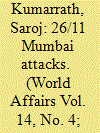

|
|
|
|
|
| Publication |
2010.
|
| Summary/Abstract |
For the Mumbai attacks of 26 November 2008, the Lashakr-e-Taiba recived training, funding and technical gadgets from the Inter-Service Intelligence (ISI) Pakistan, Middle East countries and United States (US) based companies restively. Fomenting insurgencies and supporting terrorism has been a major component of Pakistan's national strategy, especially against India. Yet t Indian security agencies are still badly trained and poorly equipped. Although, global cooperation is essential in combating international terrorism, the US has adopted selective rather than unified and comprehensive cunterterrorism measures to deal with this scourge in South Asia. It is no secret that the real rulers in Pakistan are the army and the ISI and at times they dwarf the civilian government in decision-making. If extremist forces take over Afghanistan and Pakistan, the world will become significantly less secure. However, international cooperation is not an entitlement and India must firs set its own house in order
|
|
|
|
|
|
|
|
|
|
|
|
|
|
|
|
| 2 |
ID:
101030
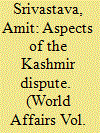

|
|
|
|
|
| Publication |
2010.
|
| Summary/Abstract |
Analysed here is the vexing Kashmir issue from various angles - firstly with regard to the lingering potential for nuclear conflict between India, Pakistan and possibly china and secondly in view of the growing socio - political alienations and divisions within both Indian and Pakistani societies, which risk disintegration as a result. The author also notes the rise of BRIC nations in the new multipolar system and places the Kashmir dispute in the context of the conflict between radicalized Muslims and people of other faiths as an aspect of the reassertion of rival culture and religious identities worldwide. Finally if India and Pakistan connot rise above their quarrel by symbiotically investing in their mutual stability, they will allow Western nation and China to dictate on outcome.
|
|
|
|
|
|
|
|
|
|
|
|
|
|
|
|
| 3 |
ID:
101028
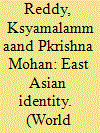

|
|
|
|
|
| Publication |
2010.
|
| Summary/Abstract |
Identity may be based on various factors like class or caste, language state, religion, nation and even continent. In the process a person acquires multiple identities and depending on a particular situation, one of the identities may dominate. In the twenty-first century, identities may also be based on regions and regional organization promotes a pan-regional identity among their people. This article examines whether it is possible for a region like East Asia to form regional organization, since the success or failure of such endeavors influence the revolution of integration. Accordingly, natural geographical and cultural boundaries as well as identity in the East Asian context, as shaped by cultural economic, historical, political and security factors, are analyzed.
|
|
|
|
|
|
|
|
|
|
|
|
|
|
|
|
| 4 |
ID:
101027
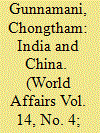

|
|
|
|
|
| Publication |
2010.
|
| Summary/Abstract |
The reconfiguration of Southeast Asia (SEA) is explored, with respect to the emergence of India and the rise of China, in shaping the region as a multipolar political space, focusing on understanding the fluidity of SEA as an economic and political source of regional power, especially in the aftermath of the diffusion of bipolar political dominance in the region with the end of the cold war.
An examination of the political economy and the formation of regional powers reveals the nature of this fluidity and its transformation. The region will play a large role in determining the futures of India and China where not only their impact on the region, but also its impact on them, will contribute to the ways, in which the two nations evolve,
|
|
|
|
|
|
|
|
|
|
|
|
|
|
|
|
| 5 |
ID:
101031
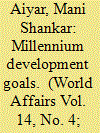

|
|
|
|
|
| Publication |
2010.
|
| Summary/Abstract |
At the commencement of this millennium, heads of governments at the United Nations adopted eight component elements of the millennium development goals (MDGs) dedicated to the overarching aim of substantially ridding our planet of the scourge of poverty within the first fifteen years of this new century. This article concentrates on the major systemic lacunae in India, which unless addressed with urgency could cripple endeavours to achieve the MDGs. It also explores India's performance and prospects in regard to a key target - the reduction by half of those living on less than a dollar a day calculated at purchasing power price and seeks to determine the proportion of people suffering from hunger.
|
|
|
|
|
|
|
|
|
|
|
|
|
|
|
|
| 6 |
ID:
101036
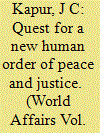

|
|
|
| 7 |
ID:
101033


|
|
|
| 8 |
ID:
101035


|
|
|
|
|
| Publication |
2010.
|
| Summary/Abstract |
One of India's leading cultural authorities attempts to answer the oft asked question: are the domains of science and culture antagonistic or complementary, even interpenetrative? The article is an overview of history, as observed by a non-scientist and is divided into four sections - working definitions of science and culture; the historiography of the debate between the tow in the twentieth century; some recent developments identifying correspondences between science and culture, more specifically Indian philosophy and traditional psychology and finally examples illustrating the interdependence of the tow domains, indeed their symbiosis are provided.
|
|
|
|
|
|
|
|
|
|
|
|
|
|
|
|
| 9 |
ID:
101032
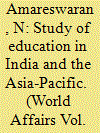

|
|
|
|
|
| Publication |
2010.
|
| Summary/Abstract |
Education is a vital foundation for individual and national development. India has one of the oldest educational traditions and academic systems and yet it has large percentage of all illiterate people in the world. This article compares the elementary and higher education infrastructures and institutions in India, China and the Asia - Pacific region. At the end , it provide suggestions and recommendations to improve the efficiency and quality of learning and training methods and processes in developing countries while highlighting the critical importance of imparting sound values.
|
|
|
|
|
|
|
|
|
|
|
|
|
|
|
|
| 10 |
ID:
101034
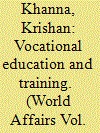

|
|
|
|
|
| Publication |
2010.
|
| Summary/Abstract |
This article on a holistic approach to vocational education and training (VET) and explores the framework, relevancy and priority of its demands in the context of India. It also analyses the connection between VET and employment, the competitiveness and the unorganized sector of the economy. Other variables which encourage the growth of VET and other related matter4s are also examined. The last section of the article discusses the use of world - class technology involving artificial intelligence for capacity building in education and training, operating the internet as a problem
|
|
|
|
|
|
|
|
|
|
|
|
|
|
|
|